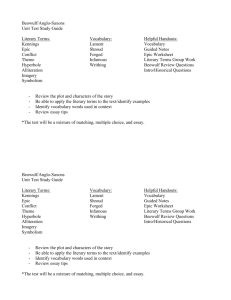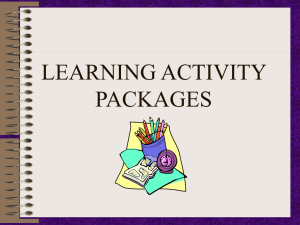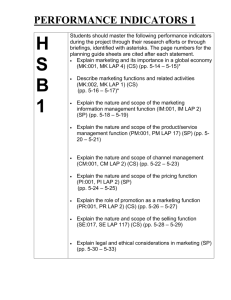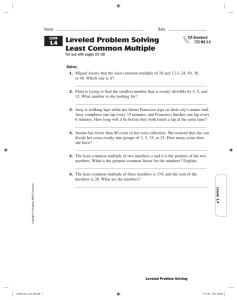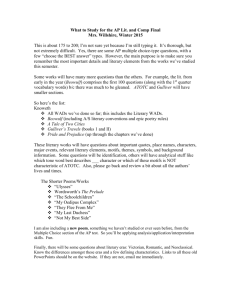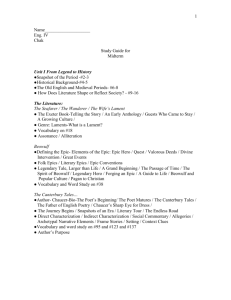INDEPENDENT LAP 1: ANGLO-SAXON & MEDIEVAL PERIODS
advertisement
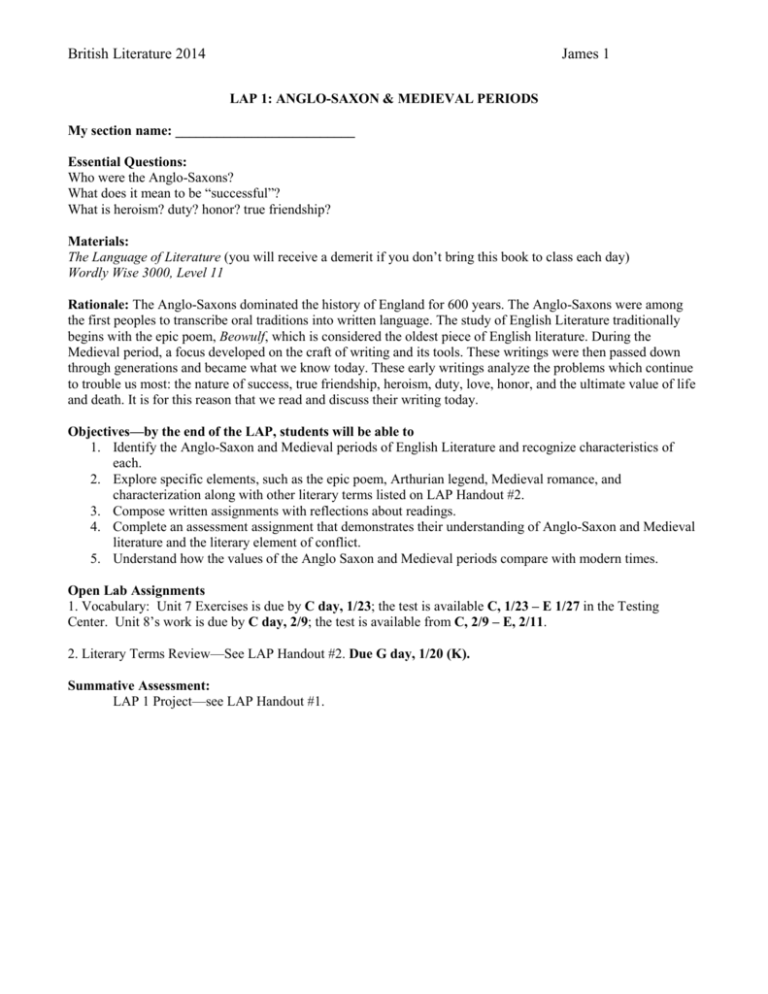
British Literature 2014 James 1 LAP 1: ANGLO-SAXON & MEDIEVAL PERIODS My section name: __________________________ Essential Questions: Who were the Anglo-Saxons? What does it mean to be “successful”? What is heroism? duty? honor? true friendship? Materials: The Language of Literature (you will receive a demerit if you don’t bring this book to class each day) Wordly Wise 3000, Level 11 Rationale: The Anglo-Saxons dominated the history of England for 600 years. The Anglo-Saxons were among the first peoples to transcribe oral traditions into written language. The study of English Literature traditionally begins with the epic poem, Beowulf, which is considered the oldest piece of English literature. During the Medieval period, a focus developed on the craft of writing and its tools. These writings were then passed down through generations and became what we know today. These early writings analyze the problems which continue to trouble us most: the nature of success, true friendship, heroism, duty, love, honor, and the ultimate value of life and death. It is for this reason that we read and discuss their writing today. Objectives—by the end of the LAP, students will be able to 1. Identify the Anglo-Saxon and Medieval periods of English Literature and recognize characteristics of each. 2. Explore specific elements, such as the epic poem, Arthurian legend, Medieval romance, and characterization along with other literary terms listed on LAP Handout #2. 3. Compose written assignments with reflections about readings. 4. Complete an assessment assignment that demonstrates their understanding of Anglo-Saxon and Medieval literature and the literary element of conflict. 5. Understand how the values of the Anglo Saxon and Medieval periods compare with modern times. Open Lab Assignments 1. Vocabulary: Unit 7 Exercises is due by C day, 1/23; the test is available C, 1/23 – E 1/27 in the Testing Center. Unit 8’s work is due by C day, 2/9; the test is available from C, 2/9 – E, 2/11. 2. Literary Terms Review—See LAP Handout #2. Due G day, 1/20 (K). Summative Assessment: LAP 1 Project—see LAP Handout #1. British Literature 2014 James 2 Schedule: As usual, I always try to remain on schedule, but things are subject to change. If you are absent, be sure to e-mail me at ajames@iwacademy.org to find out what you missed. It’s a good idea to go over the readings with me in open lab when you get back. Day 1: ___________________________ Go over syllabus and assignments—introduce class. Introduce Anglo-Saxon historical background information. Homework for Day 2: Get your syllabus signed Read pp. 18-26 in your textbook and take notes (Be sure to include the dates of important periods and key happenings or changes for each sub-topic. . Day 2: ___________________________ Discussion of reading material Introduction to Beowulf Homework for Day 3: Read Beowulf pages 30-44 Journal: 200 words, minimum (include word count). Use questions 1-4 (Thinking Through the Literature) on p. 44 as bouncing off points. This will be turned in for next class so be sure to write on looseleaf. Day 3: _______________ Go over Beowulf-- what makes an epic? Homework for Day 4: Read Beowulf pages 45-51 Journal: 200 words, minimum (include word count). Use questions 1-5 (Thinking Through the Literature) on p. 51 as bouncing off points. Day 4: ___________________________ Go over second part of Beowulf—plot triangles, point of view Homework for Day 5: Finish reading Beowulf pp. 52-60 Journal: 200 words, minimum (include word count). Use questions 1-5 (Thinking Critically) on p. 63 as bouncing off points. Day 5: ___________________________ Finish discussing Beowulf Go over information for The Canterbury Tales Homework for Day 6: Read: Author Study : 107-110 Geoffrey Chaucer (take notes) and then read The Canterbury Tales from “The Pardoner’s Tale,” page 141-151. Journal: 200 words, minimum (include word count). Use the Thinking Through the Literature questions 1-6 on p. 152 to begin. British Literature 2014 James 3 Day 6: ___________________________ Go over “The Pardoner’s Tale”—what does Chaucer value? Characterization, motivation Homework for Day 7: Read from Sir Gawain and the Green Knight p. 209-221 Journal: 200 words, minimum (include word count). Use the Thinking Through the Literature questions 2-6 on p. 222 to begin. Journals are due next class; Day 7: __________________ Go over from Sir Gawain and the Green Knight—what makes a medieval hero? Foreshadowing, romance, conflict Homework for Day 8: Work on your project—due 1/29 (G) Day 8: ___________________________ Finish discussing from Sir Gawain and the Green Knight LAP Handouts: #1: LAP 1 project guidelines #2: Literary terms open lab #3: Universal Themes British Literature 2014 James 4 LAP Handout #1: LAP 1 Project (Summative) Due 1/29 – G Day PART 1: Use of Technology Assignment: Complete Option #2, Assessing Conflict from page 269 in text. You will need to create a table in Microsoft Word for this exercise. A portion of your grade will include the clarity, quality, and easy readability of the table. Choose 4 different characters from the stories we read in this LAP. If you do not have Microsoft Word at home, then you will need to complete this exercise at school, so be sure to plan ahead. After completing the information in the table, the Assessing Conflict option has two questions which will need to be answered in paragraph form underneath the table. Each question receives its own separate paragraph. Maximum length: 50 words for each question. Value: 50 points. PART 2: Literary Terms Revisited. In order to evaluate your ability to identify literary devices and explain their use, you must give a directly quoted example for 5 out of the 9 literary terms below from one of the selections you have read in this LAP AND you must explain what effect is being created by the use of the literary device. Directions: Typed following MLA guidelines, using the title “Literary Terms Revisited” Each example must be from a different selection. You must include the title of the selection, the line numbers if applicable, and the page number of your textbook where you found the example. You must explain after the example what effect is being created by the use of the literary device. (2 points each for this part) Value: 68 points (7 pts each + 5 pts for your MLA). For example, if the term is simile, your answer should look like this: simile—“the helicopter darted like a blue dragonfly” 1984, page 23. Effect: The simile provides an easier-to-see image of how the helicopter flew so nimbly, able to dip and weave like a flying insect. ****Required Terms: kenning, alliteration, metaphor, foreshadowing, characterization, irony, protagonist, antagonist, simile. Things to remember for all projects: -You must use MLA format (see LAP Handout #2 for LAP 1 in Comp 3 if you need a review) -Grammar, spelling, and organization count! -You must include a word count for Part 1’s question answers. -I recommend working with me in Open Lab This project is due by Thursday, G day, 1/29 at 3 pm via paper. British Literature 2014 James 5 LAP Handout #2: Literary Terms Open Lab Define the following literary terms using your Glossary of Literary Terms on page 1428 of your textbook. After each entry, leave a blank space so you can write an example of the term down as we go over the terms in class. When you are finished, submit it to your appropriate class bin by the due date. 28 points. 1. antagonist— 2. caesura— 3. character— (just define “static” and “dynamic”) a. static— b. dynamic— 4. characterization— 5. Conflict (define “conflict,” “external,” and “internal”) a. internal— b. external— 6. epic— 7. foreshadowing— 8. imagery— 9. kenning— 10. Motivation—(you’ll have to look this up in the dictionary) 11. mood – 12. narrator 13. plot— (describe “plot” and each step) a. exposition b. rising action c. climax d. falling action 14. point of view: (define “point of view” and each step) a. first person b. third person limited c. third person omniscient 15. protagonist— 16. romance— 17. stock epithet—(see p. 28) 18. theme— British Literature 2014 James 6 LAP Handout #3 Anger Beauty Bravery Brotherhood Celebration Compassion Courage Cowardice Cruelty Daring Deception Desire Devotion Discovery Duty Evil Failure Fairness Fear Flattery Forgiveness Generosity Greed Harmony Heroism Honor Humility Injustice Universal Themes Inspiration Kindness Loneliness Loss Love Loyalty Modesty Nobility Perseverance Pride Rejection Resentment Resourcefulness Revenge Reverence Selfishness Serenity Sin Sisterhood Stinginess Survival Temptation Tranquility Truth Tyranny Vanity Violence British Literature 2014 James 7

